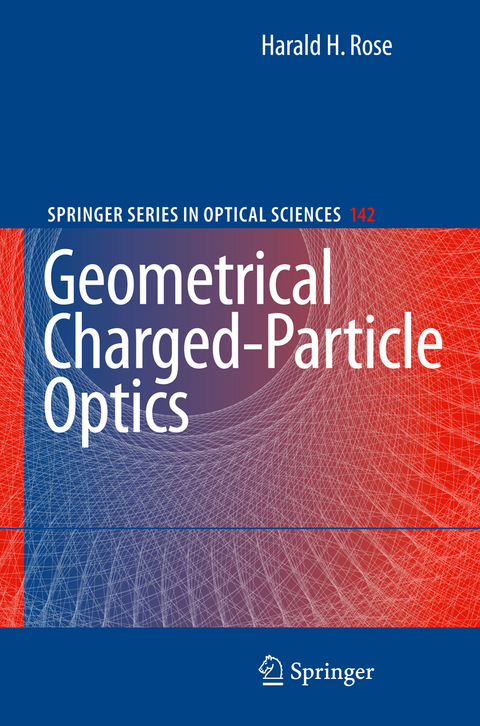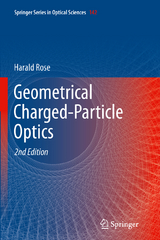
Geometrical Charged-Particle Optics
Springer Berlin (Verlag)
978-3-642-09944-1 (ISBN)
- Titel erscheint in neuer Auflage
- Artikel merken
The resolution of any imaging microscope is ultimately limited by di?raction and can never be signi?cantly smaller than the wavelength ? of the ima- forming wave, as realized by Abbe [1] in 1870. In a visionary statement, he argued that there might be some yet unknown radiation with a shorter wa- length than that of light enabling a higher resolution at some time in the future. The discovery of the electron provided such a radiation because its wavelength at accelerating voltages above 1 kV is smaller than the radius of the hydrogen atom. The wave property of the electron was postulated in 1924 by de Broglie [2]. Geometrical electron optics started in 1926 when Busch [3] demonstrated that the magnetic ?eld of a rotationally symmetric coil acts as a converging lens for electrons. The importance of this discovery was s- sequently conceived by Knoll and Ruska [4] who had the idea to build an electron microscope by combining a sequence of such lenses. Within a short period of time, the resolution of the electron microscope surpassed that of the light microscope, as depicted in Fig. 1. This success resulted primarily from theextremelysmallwavelengthoftheelectronsratherthanfromthequalityof standard electron lenses which limit the attainable resolution to about 100?. Therefore, shortening the wavelength by increasing the voltage was the most convenient method for improving the resolution. However, radiation damage by knock-on displacement of atoms limits severely the application of hi- voltage electron microscopes.
Harald H. Rose is an emeritus Professor of the Technical University Darmstadt, Germany. He received his Ph.D. degree in 1964 from this University with a thesis on theoretical electron optics under the supervision of Professor Otto Scherzer. From 1976-1980 he was a Principal Research Scientist at The New York State Department of Health and spend sabbaticals in 1973/74 at the E. Fermi Institute, Universiy of Chicago and 1995/96 at Cornell and at the University of Maryland. From 1980-2000 he was Professor at the Department of Physics of the University of Darmstadt, After his retirement he was a Research Fellow at the Department of Materials Science, Oak Ridge National Laboratory (2000/1), Department of Materials Science, Argonne National Laboratory (2001/2), and at the Advanced Light Source, Lawrence Berkeley National Laboratory (2003-2005). His main research activities are in theoretical electron optics, especially aberration correction, theory of electron scattering and image formation in EM. He has published more than 200 reviewed articles in scientific journals, 10 major review articles and is inventor of 105 patents on scientific instruments and electron optical components partly manufactured by various companies. Honorary membership in scientific societies: Honorary member of the Microscopy Society of America, the German Society of Electron Microscopy, and of the 141 Committee of the Japanese Society for the Promotion of Sciences. Awards: Distinguished Scientist Award 2003 of the Microscopy Society of America, Honorary Professor of the Jiaotong University, Xian, China (since 1987), 2005 Award of the 141 Committee of the Japanese Society for the Promotion of Sciences, Karl Heinz Beckurts Award 2006 together with Dr. Maximilian Haider and Professor Knut Urban.
General Properties of the Electron.- Multipole Expansion of the Stationary Electromagnetic Field.- Gaussian Optics.- General Principles of Particle Motion.- Beam Properties.- Path Deviations.- Aberrations.- Correction of Aberrations.- Electron Mirrors.- Optics of Electron Guns.- Confinement of Charged Particles.- Monochromators and Imaging Energy Filters.- Relativistic Electron Motion and Spin Precession.
lt;p>Aus den Rezensionen:
"... Das gut 400 Seiten starke Buch wendet sich an fortgeschrittene Studierende mit guten mathematischen Kenntnissen und an Entwickler elektronenoptischer Elemente und Systeme. Für letztere ist der Besitz dieses Werkes ein Muss, da Rose und seine Schüler die Grundlagen und Ausführungen der Korrektoren, Monochromatoren und abbildenden Energiefilter zusammengefasst behandeln. ... Beginnend wie ein Lehrbuch wandelt sich der Charakter zu einem Nachschlagewerk ... Der Leser muss hart arbeiten, um dieses auf hohem Niveau ... geschriebene Werk Roses ... zu verstehen. Aber es lohnt sich sehr ..." (Erich Plies, in: Physik Journal, August/September 2009, Vol. 8, Issue 8/9, S. 120)
| Erscheint lt. Verlag | 23.11.2010 |
|---|---|
| Reihe/Serie | Springer Series in Optical Sciences |
| Zusatzinfo | XVI, 414 p. 137 illus., 5 illus. in color. |
| Verlagsort | Berlin |
| Sprache | englisch |
| Maße | 155 x 235 mm |
| Gewicht | 649 g |
| Themenwelt | Naturwissenschaften ► Chemie ► Analytische Chemie |
| Naturwissenschaften ► Physik / Astronomie ► Atom- / Kern- / Molekularphysik | |
| Naturwissenschaften ► Physik / Astronomie ► Festkörperphysik | |
| Naturwissenschaften ► Physik / Astronomie ► Hochenergiephysik / Teilchenphysik | |
| Technik | |
| Schlagworte | Aberration correctors • Electron optics • Energy filter • Filter • Imaging • monochromator • Optics • Relativistic electron motion • Spin precession |
| ISBN-10 | 3-642-09944-0 / 3642099440 |
| ISBN-13 | 978-3-642-09944-1 / 9783642099441 |
| Zustand | Neuware |
| Haben Sie eine Frage zum Produkt? |
aus dem Bereich



